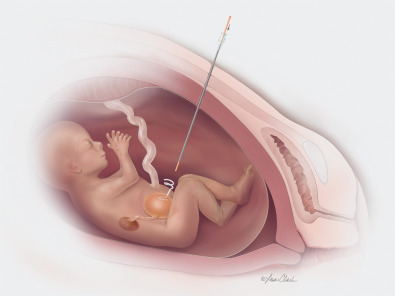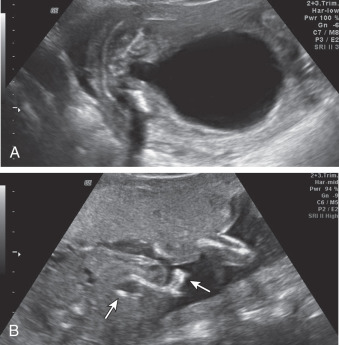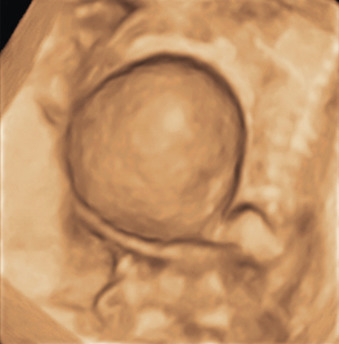Introduction
Intrauterine fetal shunts provide continuous drainage of fluid accumulations that are associated with a high risk of death or profound morbidity without decompression. The shunts are flexible plastic catheters that are percutaneously guided to a fetal location in utero under continuous ultrasound (US) guidance. Although shunt placement is considered to be minimally invasive, procedural risks and uncertain long-term prognosis despite technical success limit this therapy to motivated, well-informed patients.
Vesicoamniotic shunts for fetal bladder outlet obstruction and thoracoamniotic shunts for fetal hydrothorax are the two most commonly placed shunt types. Shunt placement may be considered for congenital cystic adenomatoid malformations (CCAM) of the thorax with a large cystic component causing fetal compromise. Case reports also exist of shunt placement for massive fetal pericardial effusion, although the benefit of this intervention is unproven. Historically, shunt placement was also considered for severe fetal hydrocephalus, but this is no longer a standard management option.
Fetal lower urinary tract obstructive uropathy, which causes an overdistended urinary bladder and a highly pressurized collecting system, places the fetus at substantial risk for renal insufficiency or failure in addition to ureteral and bladder dysfunction. Long-standing severe oligohydramnios or anhydramnios is usually associated with obstructive uropathy, which subjects the fetus to pulmonary hypoplasia that can severely limit or preclude survival after birth. A vesicoamniotic shunt performed sufficiently early decompresses the bladder and reconstitutes the amniotic space, allowing pulmonary development. Theoretically, it may also prevent further renal, bladder, and ureteral damage because of high pressure within the genitourinary system, although there are insufficient published data to validate this claim.
Because of a variable natural course after the diagnosis of fetal hydrothorax, thoracoamniotic shunt placement is generally reserved for severe prenatal presentations involving hydrops, polyhydramnios, evidence of fetal cardiovascular compromise, or rapid fluid reaccumulation following thoracocentesis. Although perinatal mortality for conservatively managed isolated fetal hydrothorax is approximately 37%, the aforementioned factors diminish survival prognosis. Some interventionists consider significant mediastinal shift without hydrops or polyhydramnios as an indication for intervention. In candidates for therapy, shunt placement decompresses the pleural space, allowing for pulmonary expansion within the thoracic cavity, which may promote pulmonary development. By reducing intrathoracic pressure, shunt-facilitated continuous drainage may also increase venous return to the fetal heart and improve overall hemodynamic performance.
Vesicoamniotic Shunt
Description, Technique, and Equipment
Fetal shunts are designed with a double-pigtail shape to prevent dislodgment after placement. Although several options exist, the two most common types are the Rocket (Rocket KCH Fetal Bladder Drain; Rocket Medical, Hingham, MA) and Harrison (Harrison Fetal Bladder Stent Set; Cook Medical Inc., Bloomington, IN) shunts. The Harrison shunt ( Fig. 116.1 ) is smaller than the Rocket (1.7-mm diameter versus 2.1-mm diameter) allowing introduction through a narrower, 13-gauge needle (2.4-mm diameter) than the cannula used for Rocket shunt placement (3.0-mm diameter). Although narrower shunts are intuitively associated with decreased risk of premature rupture of membranes and perhaps iatrogenic fetal injury, these shunts may be more prone to obstruction, migration, and dislodgment, which increase the likelihood of needing a repeat shunt. No robust data exist showing superiority of one particular type over another, and shunt selection remains a matter of physician discretion.

Before shunt placement, a diagnosis of fetal bladder outlet obstruction must be confirmed. Outlet obstruction is usually accompanied by severe oligohydramnios. US scanning reveals a markedly distended fetal bladder. A “keyhole” appearance indicates a dilated proximal urethra suggestive of posterior urethral valves as the cause of obstructive uropathy ( Figs. 116.2 and 116.3 ). Bladder wall thickening may suggest long-standing obstruction. Bilateral hydronephrosis and enlarged kidneys with an irregular and echogenic echotexture are additional diagnostic indications. Bilateral hydroureters may also be apparent ( Chapter 14 ). The US examination should include visualization of the external genitalia because lower urinary tract obstruction is usually, but not always, associated with male gender.


Following diagnosis, the patient should be counseled regarding the natural history of obstructive uropathy and an extremely poor fetal prognosis without intervention. In addition to options of expectant care and pregnancy termination, if within legal gestational limits, the possibility of vesicoamniotic shunt therapy should be introduced with a discussion of procedure-related risks and potential benefits. Alternative approaches involving open fetal surgery for vesicostomy, fetal cystoscopy, and fetoscopic transurethral catheterization may also be offered at selected quaternary care fetal therapy centers; however, there are no data indicating that these approaches offer benefits outweighing any additional maternal and fetal risks when compared with percutaneous vesicoamniotic shunt placement.
Informed consent for vesicoamniotic shunt placement requires the interventionist to explain to patients that this therapy does not reverse preexisting renal damage or pulmonary compromise; however, it may prevent further injury. Counseling must stress that even with technically successful shunt placement, a significant chance remains of delivering a surviving child with severe long-term genitourinary and pulmonary compromise.
Urinalysis by vesicocentesis is recommended when considering a fetal candidate for shunt therapy because of an inconsistent correlation between US appearance of the fetal kidneys and degree of renal dysplasia and dysfunction. The rationale for fetal urinalysis derives from an understanding of fetal urinary production. Owing to resorption at the level of the proximal tubules, fetal urine is a hypotonic ultrafiltrate of fetal serum that becomes progressively more hypotonic with advancing gestational age until the middle of the third trimester (see Chapter 14 ). However, in the setting of progressive uropathic injury, the proximal tubules can be damaged, resulting in urine that is relatively hypertonic for gestational age.
Two or three vesicocenteses are required to determine if the resultant urinary analyte profile is favorable. Because of concern that the initial vesicocentesis may not be reflective of current renal function, a series of up to three vesicocenteses (spaced approximately 48 hours between samplings) should be performed before offering vesicoamniotic shunt placement. Serial vesicocenteses are believed to give a better representation of current renal function because the urine sampled in an initial vesicocentesis sample has been pooled over weeks. Vesicocenteses are performed with a 20- or 22-gauge needle under continuous US guidance, using standard aseptic technique. Karyotype determination should be performed at the same time.
Although no single urinary analyte predicts long-term renal function with great accuracy, a urinary profile pattern that suggests preserved renal function should be obtained before shunt placement. Initial studies established urinary electrolyte (sodium <100 mg/dL, calcium <8 mg/dL, chloride <90 mg/dL), osmolality (<200 mOsm/L), and protein (beta-2-microglobulin <4 mg/L, total protein <40 mg/dL) concentrations as test cutoffs. Numerous subsequent series showed that these thresholds possess moderate ability to successfully differentiate fetuses that might benefit from shunt therapy from fetuses with irreversible damage. A systematic review of the literature suggested that using sodium concentration greater than the 95th percentile for gestational age may be more accurate than using absolute thresholds.
Cases presenting before 20 weeks’ gestation pose a particular challenge. Early second-trimester fetal urine is nearly isotonic with fetal plasma, presumably owing to immature tubular function. Nomograms for these earlier gestational ages are lacking. Screening before 20 weeks’ gestation must consider that nomograms, normally consulted for risk assessment, are lacking for these earlier evaluations.
Other proposed forms of renal evaluation before shunt placement include fetal blood sampling (to measure beta-2-microglobulin concentration) and renal biopsy. Because of invasiveness and unproven benefit over urine sampling, these techniques have not been widely adopted.
Vesicoamniotic shunt placement is performed under continuous US guidance, usually after administering lidocaine along the entry approach. A target site over the distended fetal bladder is identified, ideally at a level between the umbilical cord insertion and the symphysis pubis when technically possible. This more caudal placement is recommended because as the fetal bladder is decompressed within the fetal pelvis, a lower shunt stands a reduced risk of becoming kinked or dislodged. Placement should also target the fetal midline, or immediately lateral to it, to decrease risk of iatrogenic vascular or intestinal injury. Color Doppler can assist in identifying the course of the umbilical arteries along the distended bladder before placement. After placement, the fetal bladder should rapidly decompress, and amniotic fluid volume should gradually reaccumulate.
Perioperative antibiotics (cephalosporins are used at our center) are recommended, administered intravenously before the procedure or injected into the amniotic sac after the procedure. Intraamniotic antibiotics may also be used, and are recommended with placement of the Rocket shunt. Some interventionists administer universal tocolysis; others reserve therapy for cases with evidence of contractions after the procedure.
Bladder outlet obstruction with severe oligohydramnios or anhydramnios may first require amnioinfusion to facilitate vesicoamniotic shunt placement. Amnioinfusion may also allow for a more detailed fetal anatomic survey. When performed, 300–500 mL of lactated Ringer solution may be infused via a 20- or 22-gauge spinal needle to reconstitute the amniotic space along the fetal abdominal wall. Some groups routinely warm the saline using a blood transfusion warmer; others do not. Care must be taken during this step because improper needle location may result in creation of an amnion-chorion separation that can preclude shunt placement. Care after the procedure includes weekly US observation to ensure that the shunt remains in situ and functions properly.
Indications
As noted earlier, shunt placement is considered for a fetus with US evidence of obstructive uropathy, including oligohydramnios. Before vesicoamniotic shunt placement, a favorable fetal urinary analyte profile should be obtained. Informed consent is necessary before shunt placement.
Contraindications
Absolute contraindications include early gestational age (<16 weeks) because this may increase risk of membrane rupture, preterm premature rupture of membranes (PPROM), preterm labor, and active placental abruption. Other contraindications include a patient’s decision for termination or nonintervention. Relative contraindications include fetal aneuploidy, associated major fetal anomalies, and maternal infectious diseases (i.e., human immunodeficiency virus, hepatitis C); in these cases, the risks of vertical transmission must be considered against the potential benefits of shunt placement.
The management of bladder outlet obstruction with US preserved amniotic fluid volume is controversial because the natural history with this presentation is unclear. There are no data to indicate a benefit to shunt placement; however, this presentation has not been well studied. Vigilant US surveillance may be considered in this setting, with a plan for shunt placement if evidence of oligohydramnios develops.
Another controversy involves vesicoamniotic shunt placement for fetuses with urinary analyte profiles suggestive of poor renal function. In these cases, nonintervention is routinely recommended, with a plan for pregnancy termination or postnatal comfort care.
Outcomes and Complications
Outcomes data are largely relegated to case series describing single-institution experiences with vesicoamniotic shunt placement. Recently, results of the sole completed and randomized trial attempting to prospectively assess vesicoamniotic shunt efficacy among fetal lower urinary tract obstruction presentations was published. The study was prematurely stopped because of poor recruitment, with only 16 shunt cases and 15 controls, which was far short of a target recruitment of 150 subjects. Although intention-to-treat analysis did not demonstrate a survival benefit to shunting, there was a significant survival benefit when subjects were compared by treatment received. Long-term renal morbidity was substantial in both groups, suggesting little renal-protective benefit to shunt therapy. Notably, there was a high rate of procedural complications, with over half of all shunt placements complicated by PPROM, dislodgement, or occlusion. Overall, these data suggest that while vesicoamniotic shunt placement may confer a survival benefit, renal morbidity is expected to be substantial among survivors regardless of fetal therapy received.
Beyond the results of the PLUTO (percutaneous shunting in lower urinary tract obstruction) randomized trial, an uncontrolled comparison with the natural disease course is further suggestive of a survival benefit to the shunt procedure. In a retrospective analysis by Crombleholme et al., untreated oligohydramnios was associated with a 100% mortality rate, whereas normal or restored amniotic fluid volume was associated with 94% survival.
Short-term periprocedural complications of vesicoamniotic shunt placement include PPROM, preterm labor, premature delivery, chorioamnionitis, bleeding, and abruption. Shunts may be misplaced or migrate into the fetal abdominal cavity over time, resulting in urinary ascites requiring surgical removal after birth. Shunts may also dislodge or become occluded, potentially requiring repeat shunt placement. Shunts may be placed entirely within the fetal bladder or may migrate there, necessitating repeat shunt placement and postnatal removal. There is risk of fetal injury, including injury to vascular, intestinal, and genitourinary structures. The fetal bladder may rupture at the time of shunt placement. There is a small risk of fetal vascular injury leading to death and risk of fetal bowel evisceration through a trocar entry site. Theoretic risk for maternal small bowel or uterine injury exists, although the former is highly unlikely because the procedure is performed under continuous US guidance. Maternal ascites as a result of amniotic fluid leakage through a uterine trocar wound has been described.
Although short-term data support a survival benefit with vesicoamniotic shunt placement, long-term series suggest that survivors are at risk for potentially severe morbidities involving the genitourinary and pulmonary systems. Renal, bladder, and other genitourinary complications are likely related to degree of obstruction and type of underlying obstructive uropathy, with pulmonary morbidities attributable to duration and severity of oligohydramnios. Even among survivors with favorable urinary analyte profiles before shunt placement, there is significant risk for long-term renal insufficiency, end-stage renal failure, dialysis requirement, and ultimate renal transplantation. In small series, risk of long-term renal failure seems to be at least 33% among shunt survivors. Long-term bladder dysfunction is also reported, with survivors at risk for recurrent urinary tract infections or self-catheterization requirements. In addition, these children commonly have musculoskeletal and growth disturbances and potential developmental delays. When oligohydramnios is severe and prolonged, limb positioning abnormalities and Potter facies can be observed.
Stay updated, free articles. Join our Telegram channel

Full access? Get Clinical Tree






